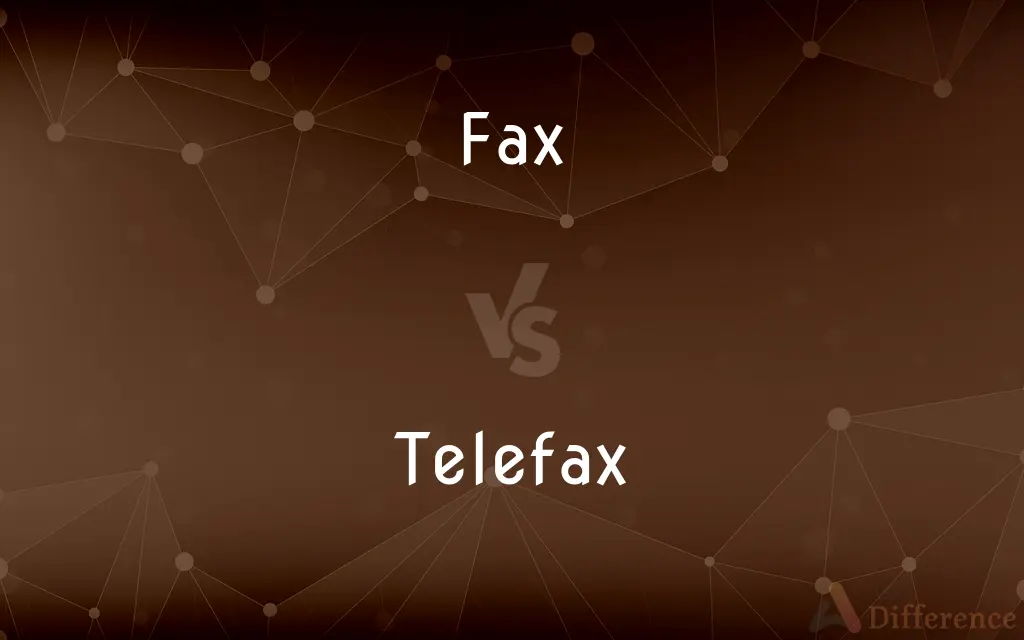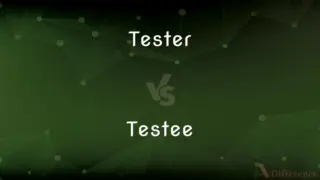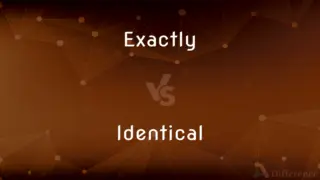Fax vs. Telefax — What's the Difference?
By Fiza Rafique & Maham Liaqat — Updated on March 27, 2024
Fax is a shortened term for telefax, both referring to the transmission of scanned printed material.

Difference Between Fax and Telefax
Table of Contents
ADVERTISEMENT
Key Differences
Fax, short for facsimile, involves sending scanned printed materials (like text or pictures) from one place to another through a telephone network. It's a telecommunications technology that became widespread in the 20th century, enabling documents to be sent over long distances quickly. Telefax, essentially another term for fax, emphasizes the use of telecommunication facilities to send facsimiles. It's a compound word combining "tele" (meaning distance) and "fax" (short for facsimile), underscoring the technology's reliance on telephone networks for document transmission.
The distinction between fax and telefax is largely historical and contextual. While "fax" has become the more commonly used term, "telefax" might be found in more formal or technical contexts, highlighting the method of transmission. Both terms describe the same process and technology, and their usage varies by region and preference.
In terms of functionality, both fax and telefax machines work on the same principle: encoding and decoding documents for transmission over a phone line. The sender's machine scans the document, converts it into a bitmap, and then transmits it. The receiver's machine decodes the signal and prints a copy of the original document.
Despite the rise of digital communication methods, fax and telefax machines are still used in various sectors, particularly where document authenticity and a paper trail are important. They serve similar purposes in offices, legal settings, and healthcare facilities, providing a secure method of sending sensitive information.
Comparison Chart
Terminology
Abbreviated form of facsimile.
Full term combining "tele" and "facsimile."
ADVERTISEMENT
Usage
More commonly used, especially informally.
More formal or technical, less common.
Function
Transmission of documents via telephone lines.
Same as fax.
Technology
Uses encoding and decoding of images.
Identical technology and process as fax.
Modern Use
Still used for secure document transmission.
Same as fax, with identical purposes.
Compare with Definitions
Fax
The act of faxing.
Faxing documents is still required in some legal procedures.
Telefax
The action of sending a document via telefax.
Telefaxing the proposal will ensure it arrives securely.
Fax
A machine for sending and receiving faxes.
The office fax is out of toner.
Telefax
A system for transmitting documents over telephone lines.
The lawyer requested the documents be sent via telefax for a legal record.
Fax
The process of using a fax machine.
Fax me the documents by noon.
Telefax
The machine used in telefaxing.
The telefax machine in the office has been reliable for years.
Fax
The transmission of scanned printed material.
She sent the contract via fax yesterday.
Telefax
A document transmitted through telefax.
A telefax arrived with the signed agreements.
Fax
A document received or sent by fax.
He received a fax from the bank with the approval letter.
Telefax
The use of telefax technology.
Despite email, telefaxing remains prevalent in healthcare for patient records.
Fax
Fax (short for facsimile), sometimes called telecopying or telefax (the latter short for telefacsimile), is the telephonic transmission of scanned printed material (both text and images), normally to a telephone number connected to a printer or other output device. The original document is scanned with a fax machine (or a telecopier), which processes the contents (text or images) as a single fixed graphic image, converting it into a bitmap, and then transmitting it through the telephone system in the form of audio-frequency tones.
Telefax
Synonym of telefacsimile
Fax
A fax machine.
Telefax
(transitive) To transmit by telefacsimile.
Fax
A document transmitted or received by a fax machine. In both senses also called facsimile.
Telefax
Send something via a facsimile machine;
Can you fax me the report right away?
Fax
To transmit (a document) by a fax machine.
Fax
The hair of the head.
Fax
Senseid|en|machine}} {{ellipsis of fax machine
Fax
A document sent, or received and printed by a fax machine
Fax
To send a document via a fax machine.
Fax
Alt form of facts.
Fax
Duplicator that transmits the copy by wire or radio
Fax
Send something via a facsimile machine;
Can you fax me the report right away?
Common Curiosities
What is the main difference between fax and telefax?
The terms are interchangeable; "fax" is simply a shortened form of "telefax."
Are fax and telefax considered outdated technology?
While considered less modern, they are still crucial in contexts requiring secure document transmission.
How do fax and telefax work?
They scan documents, convert them into a bitmap, and transmit them over telephone lines for the receiver to print.
Can fax and telefax machines send documents to email?
Yes, modern machines and services can convert fax transmissions to emails and vice versa.
Why is fax still used despite digital alternatives?
Fax is used for its security and the legal validity of transmitted documents, especially in sectors like law and healthcare.
What are the alternatives to fax and telefax?
Email, secure document sharing platforms, and cloud services are common alternatives.
Can digital signatures be sent via fax or telefax?
Yes, digital signatures can be faxed, as the fax machine transmits an image of the document.
Can faxed documents be legally binding?
Yes, faxed documents are often considered legally binding and can serve as legal documents.
Why might someone choose telefax over email?
Due to security concerns and the legal authenticity of documents transmitted via telefax.
What future do fax and telefax have?
While their usage is declining with digitalization, they remain relevant for secure, legally valid document transmission.
Are there any security risks with fax and telefax?
Like any communication method, there are risks, but secure fax transmissions are generally considered safe.
How can I receive a fax without a fax machine?
Through online fax services that provide a virtual fax number and email the received fax to you.
Is a telephone line required for fax or telefax?
Traditionally, yes, though there are now internet-based services that simulate the fax process without a physical line.
Is there a difference in quality between fax and telefax transmissions?
No, the quality of transmission depends on the machines and the connection, not the terminology.
How does one send a fax or telefax internationally?
By dialing the international access code, the country code, and the recipient's fax number.
Share Your Discovery

Previous Comparison
Tester vs. Testee
Next Comparison
Exactly vs. IdenticalAuthor Spotlight
Written by
Fiza RafiqueFiza Rafique is a skilled content writer at AskDifference.com, where she meticulously refines and enhances written pieces. Drawing from her vast editorial expertise, Fiza ensures clarity, accuracy, and precision in every article. Passionate about language, she continually seeks to elevate the quality of content for readers worldwide.
Co-written by
Maham Liaqat















































